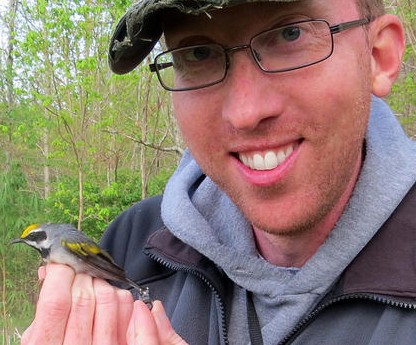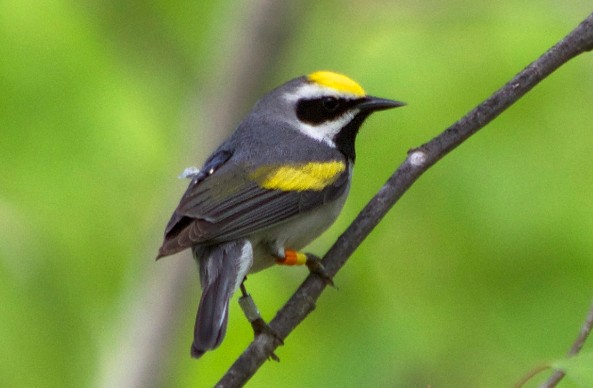An accidental discovery made by researchers testing the weight-bearing capacities of a small bird in the Tennessee mountains has shed light on how birds’ senses–notably their ability to hear very low infrasounds characteristic of large storms–allow the animals to avert meteorological catastrophes.
“I think this is just one newly discovered example of the many ways other animals perceive and interact with their environment that are different from how we humans work, Dr. Henry Streby of Beissinger Lab at UC Berkeley, the lead author of the study, told The Speaker.

“We tend to assume other animals are hearing, seeing, and smelling things the same way we do, but we know many other animals sense things far outside of the range of our senses. It is difficult to imagine what goes on in a bird’s brain; they hear higher and lower frequency sounds that we do and they see in a much wider light spectrum and a more complicated color space than we do. Our study, and others tracking migratory birds, are starting to show some of the ways birds can use their impressive senses to get around and stay safe from weather and other dangers.”
The team was working in the Cumberland Mountains of eastern Tennessee, testing the weight-bearing capacity of a small bird.
“A golden-winged warbler weighs only 9 grams, which is less than the mass of 2 US nickles or one British Pound coin,” Streby described his subject. They wanted to know if the bird could carry geolocators on their backs.
Around 24 hours before a large storm blew into the area, spawning 84 tornadoes and killing at least 25 people, the warblers unexpectedly picked up and moved 1,500 kilometers in five days. The team was able to monitor their movements because of the devices they had saddled some of the birds with.
Streby qualified that he couldn’t say with certainty that the birds flew in large groups.
“Our sample of birds carrying tracking devices was quite small, but we suspect they were not the only ones that left,” Streby said. “Although these movements seem impressive, and they occurred outside of the birds’ normal migration period, they were well within the known capabilities of these birds. The birds in this population regularly make similar long distance movements during their spring and fall migration to and from Colombia.”
However, the timing and character of the birds’ movements led the researchers to conclude that a mass temporary relocation took place when the birds sensed that the massive storm was headed their way.
“People have been studying this species on the breeding grounds for decades, but we only just started tracking their migration during this study,” Streby told us.
“Movements like this have not been reported before, and we did not see anything like this during the previous year with this population or with another population we were tracking that was not in the storm’s path. So, basically, we have an extraordinary large-scale movement away from the breeding grounds and back again, that correlates perfectly with the timing of this enormous and powerful storm. Avoiding the storm is the most likely explanation.”
The warbler, like other birds, are particularly attuned to hearing weather, Streby explained. “We know birds are particularly attuned to these very low infrasounds, and we know that large tornado producing storms create infrasound in the exact same frequency range, but nobody had put the two together until this report.”
Next, the team will undertake a further phase of their research, which is expanding in unpredicted ways–they will be collecting data from hundreds of migrating birds, and the team is looking forward to new unexpected developments.
“In 2015, we will be marking more than 400 birds of this species and a closely related species at 16 sites across their entire breeding range. Our goal is to find out where all of these populations spend the winter and where the important resting and refueling places are along their migration routes. These species are of high conservation concern and we are hoping to better understand the challenges they face during all aspects of their annual cycle. We did not intend to study how these birds respond to extreme weather events, but if they encounter any storms like the one from 2014, or maybe have to fly around a hurricane during migration, or something else completely unexpected, I’m excited to see what they do.
“We shouldn’t assume animals perceive their environment the same way we do,” Streby said. “We are lucky to have all of our experts and technology monitoring the weather and warning us when tornadoes or other dangers are coming our way. It is amazing to discover the different tools wildlife have for knowing what is coming too. It is also important for readers to understand that these birds apparently sensed the storm at a great distance, and there is a logical scientific explanation for how they did it; they did not magically detect the storm long before it existed like many media outlets have suggested.”
The report, “Tornadic Storm Avoidance Behavior in Breeding Songbirds,” was completed by Henry M. Streby, Gunnar R. Kramer, Sean M. Peterson, Justin A. Lehman, David A. Buehler, and David E. Andersen, and was published in the online Current Biology.
By Sid Douglas
